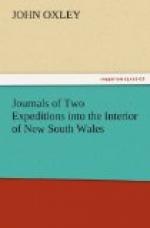tolerably easy acclivity, we gained that which I took
to be the highest of these congregated hills, in hopes
it might possibly lead into a main range. From
its summit we had a very extensive prospect over the
country we had left, and also to the southward, in
which direction the land appeared broken and hilly,
and but thinly clothed with timber. To the east
and north-east it appeared far less broken, and certainly
less elevated than the ridge we were on. This
ridge soon expanded to a broad surface of open forest
land, and proceeding on it to the east about a mile,
we perceived in the valley beneath us a considerable
and rapid stream running to the north, and afterwards
apparently taking a more easterly direction.
A more remarkable change in the outward appearance
of a country was perhaps never before witnessed.
In less than a mile, the timber had entirely changed
from the bastard box to another kind of eucalyptus,
called common blue gum, which grew in great luxuriance
in the country before us. Until now this species
had never been seen except on the immediate banks
of running streams. In the course of the day,
great quantities of fine stringy bark were also seen.
The soil, instead of the light black mould, which
had been the general covering of the country, was
now changed to a stiff tenacious clay; and although
well clothed with grass, its less luxuriant growth
evidently showed the difference of soil not to be
favourable. From this hill or range we descended
very gradually for nearly two miles to the river before
seen, and up the banks of which we proceeded about
a mile farther, when we halted for the evening.
The country was perfectly open, though much covered
with fallen timber; the banks of the river sloping
and quite clear of timber; and being within one hundred
miles of the sea coast, I had a strong belief that
we had descended from the highest land, and that we
should meet with no dividing ranges in the course
of our future progress. It is impossible to form
any certain conclusion at present, as to the course
taken by this stream. Whether it finds its way
to the coast, or is lost like the other streams of
this country, will, I think, in a great measure depend
upon the fact of our having crossed the highest ranges
of the country. One of the men who had taken
the dogs out after kangaroos fell in with a party of
natives, among whom were some women and children.
Two of the men accompanied him to the tent. It
was evident from the whole tenor of their behaviour
that they had previously heard of white people (most
probably from the settlement at New Castle); their
appearance was most miserable, their features approached
deformity, and their persons were disgustingly filthy:
their small attenuated limbs seemed scarcely able to
support their bodies; and their entire person formed
a marked contrast to the fine and manly figures of
their brethren in the interior. We gave them a
small turtle which we had just caught in the river,
and they sat down to dress it instantly. In fact,




